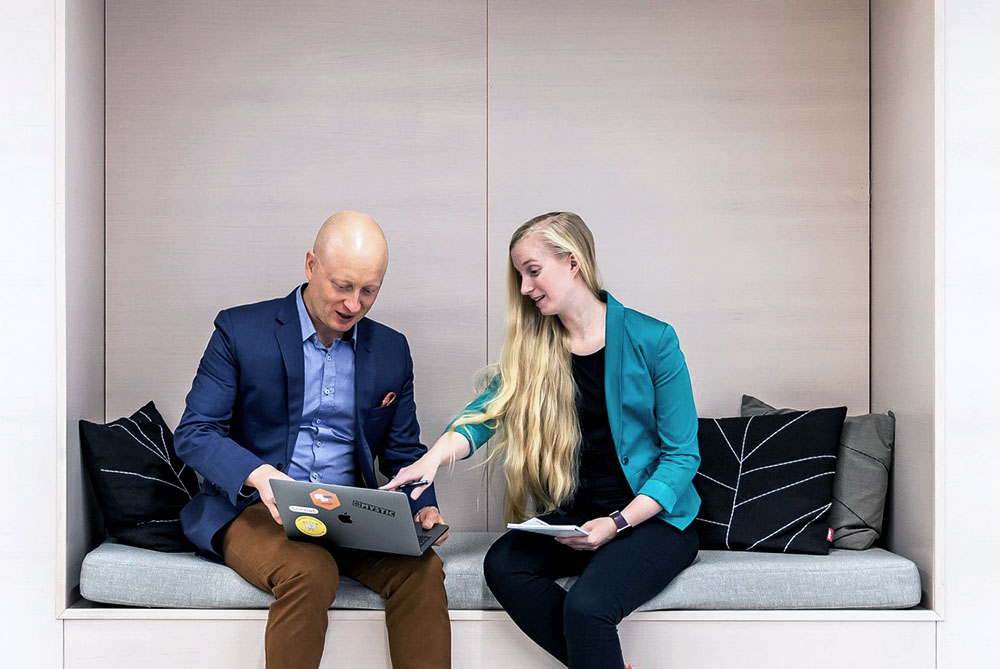If you want your product or service to succeed, engage users early on and in every step of the development. No matter how cutting-edge your technology – if it doesn’t fit users’ needs, they won’t use it. Constant feedback from users helps in keeping the focus on the important things. Which in the end saves money and makes the product enjoyable to use.
Picture this: It’s a typical Monday morning at work and you’re trying to get your routine daily tasks done. At hand, you have a task that requires you to use a system or program that is not actually your favourite for many reasons. But since you’ve done it many times before, you’ve become a master at it. Maybe you’re handling invoices or retrieving information about your customers from CRM. As you sip from your first cup of coffee you sigh: “If only there was an easier way to do this…”

Scenario A: Designing technology first
You realise that a new button called “AI assistant” has appeared on the screen. Since you’re a tiny bit intrigued by it, you might as well see what it’s about. So, you click the button and “Heidi Helper” pops up on your screen. It seems that Heidi wants some information from you in order to be helpful, but it takes a lot of time to understand her needs. Also, you’re quite unsure what Heidi can do for you in the end: Will she handle my invoice all together or just some part of it? Will she just gather information and do some data-crunching without me knowing what is happening? You’re starting to think: “Maybe, I should’ve just done the invoice like I usually do. I would probably be done with it already and could be drinking my second cup of coffee with my colleagues.”
Scenario B: Designing user first
You realise that a new button called “AI assistant” has appeared on the screen. You’re thrilled about it: “It’s finally here! At last, I can get some help with these routine tasks!” So, you push the button and “Heidi Helper” pops up on your screen. Since you were part of the design process, you know exactly what information Heidi needs from you to make you get the job done faster. You also know, that by inserting all the required data, Heidi can learn to combine relevant information together quicker than you could ever possibly be able to. So, by helping Heidi now, she will be your trusted ally in the future. You would never go back to working the way you did before her.
Which scenario would you choose: The one where technology is pushed on the users without proper reasoning or training or the one where the users were involved in the design process to make the technology fit their needs? The answer is simple, right?
How we involved users in the AI design process
In our project of designing an AI assistant, we wanted to make sure that the actual users of the assistant would be in the centre of the design process. Our goal was to a) understand how they use the system, b) identify the pain points in getting their tasks done with the system and c) design an AI assistant that would resolve the issues they are facing right now and ease their work.
Here’s the process we followed in our work:
- Assemble a multi-faceted team with experts in user research, UI design and data science
- Conduct user interviews and observations to understand how the system is used in completing daily tasks. Put emphasis on digging out how they feel about the system, how does it work in their favour and what are the things they struggle with.
- Conduct a workshop together with the users where you illustrate their work process on a canvas. In our case we wanted to understand the following aspects:
- All the phases to complete the task
- The data and information sources they need for each phase
- The challenges they face in each phase
- The initial solutions for each challenge
- Design a technical solution that responds to the challenges identified in the research phase. Communicate the benefits of using it in a comprehensible manner to the users and make changes if needed.
- Design the user interface for the AI assistant and demonstrate to the users how the assistant would actually work in their environment. Use a technology that allows the users to get acquainted and test the prototype by themselves.
By placing the users in the heart of the design process, you can provide an AI assistant that brings the most joy and helps the users get manual work done more efficiently and automatically. It should also be remembered to gather feedback from the users and analyse usage data constantly to optimise the product for even greater user experience.
After the user-centric design process
While using Heidi Helper for some time already you don’t even notice it anymore. All the learning material you’ve provided to Heidi has made the AI assistant better and better each day. You feel confident when dealing with invoices because you know you don’t have to take care of everything by yourself.
The greatest thing is the liberating feeling when you can focus on the most important and challenging work and let the AI assistant take care of the more trivial but time-consuming tasks. While Heidi Helper browses through tens of email attachments in order to find missing invoice details, you’re able to combine information from several sources with unforeseen pace. Also, now you have time for that extra cup of coffee.



